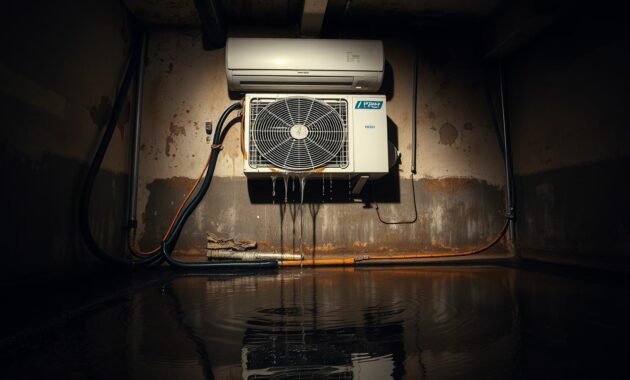Seeing water in your air conditioning unit’s drain pan is alarming. It means there might be problems that could harm your cooling system and your home. I’ll explain why your ac drain pan might be full and what steps to take to avoid costly fixes.
An overflowing AC drain pan is more than just a small problem. It can show serious issues with your air conditioning that need quick action. Problems like clogged drain lines or installation mistakes can get worse fast if ignored.
In this guide, I’ll share key info on AC drain pan water issues. You’ll learn how to spot, fix, and solve these problems before they lead to expensive repairs.
Understanding Your AC’s Drain Pan System
Your air conditioning system has a key part that many homeowners overlook: the drain pan. It’s a hero that helps manage moisture and stops water damage. Let’s explore how it works.
How Condensation Forms in Your AC
When your AC runs, it makes condensation. Warm air meets cold coils, turning moisture into water droplets. It’s like water beads on a cold glass on a humid day.
- Warm air enters the AC unit
- Air passes over cold evaporator coils
- Moisture condenses into water droplets
- Water collects in the drain pan
The Role of the Drain Pan
The drain pan catches all the water from cooling. It collects condensation and sends it away through the drain line. Without it, water could damage your home.
Read also: 3 Basic Tips on Draining Water from Portable Air Conditioner
Normal vs. Abnormal Water Levels
It’s important to know when your drain pan has too much water. A little water is okay, but too much means trouble.
| Water Level | Status | Recommended Action |
|---|---|---|
| Minimal water | Normal | No action needed |
| Standing water | Potential issue | Inspect drain line |
| Overflowing pan | Serious problem | Immediate professional inspection |
Watching your drain pan helps avoid water damage and keeps your AC running well.
Common Signs of AC Drain Pan Problems

Spotting hvac drainage problems early can save you from costly water damage and system failures. As a homeowner, I’ve learned it’s key to recognize ac condensate overflow signs. This helps keep your air conditioning system running smoothly.
Air conditioning water backup shows several clear signs that shouldn’t be ignored. Look out for these important indicators:
- Water pooling around your indoor AC unit
- Unexpected water stains on walls or ceilings
- Musty odors suggesting possible mold growth
- Sudden system shutdowns
- Visible moisture or condensation near the drain pan
These signs usually mean your drain pan is facing big issues. Water buildup around your AC unit can quickly turn from a small problem to a big one. Ignoring these signs can lead to structural damage, higher humidity, and health risks from mold.
Professional HVAC technicians say to get an inspection right away if you see any of these signs. Acting fast can avoid expensive repairs and protect your home from water damage.
Why Is Your AC Drain Pan Full of Water
Knowing why your AC drain pan fills up can help avoid water damage and expensive fixes. Several key factors can make your evaporator pan overflow. This can harm your air conditioning system.
Clogged Drain Lines
A clogged drain pipe stops water from leaving your air conditioner. Dirt, algae, and other debris can block the line. This stops water from draining, causing it to pool in the pan.
- Algae growth blocking drainage
- Accumulated dust and debris
- Mineral deposits from hard water
Frozen Evaporator Coils
Frozen evaporator coils make managing water hard. Low refrigerant or dirty air filters can cause the coils to freeze. When they thaw, they produce a lot of water, which can fill the drain pan too much.
| Cause | Potential Impact |
|---|---|
| Low Refrigerant | Increased Freezing Risk |
| Dirty Air Filters | Restricted Airflow |
| Blocked Vents | Reduced System Efficiency |
Installation Issues
Bad AC installation can lead to drain pan problems. The wrong pan size, bad drainage angle, or wrong drain line placement can stop water from flowing out. This causes water to keep building up.
- Check pan alignment
- Verify drain line slope
- Inspect professional installation quality
By spotting these problems early, you can stop water damage. You can also keep your air conditioning system running well.
Risks of Ignoring a Full Drain Pan
Keeping your home safe from AC water damage is very important. A wet condensate pan might seem small, but it can turn into a big problem. It can harm your property and health.

- Structural damage to floors, walls, and ceilings
- Electrical component destruction
- Dangerous mold and mildew growth
- Potential slip and fall accidents
Ignoring a full drain pan can lead to costly repairs. Water damage can rot wood, weakening your home’s foundation. Electrical systems near the wet condensate pan are at risk of short circuits or fires.
Read also: AC Compressor Tripping After Few Minutes
| Risk Category | Potential Damage | Estimated Repair Cost |
|---|---|---|
| Structural Damage | Floor and wall deterioration | $500 – $5,000 |
| Electrical Damage | AC system component failure | $200 – $1,500 |
| Health Risks | Mold and mildew growth | $500 – $6,000 |
Acting fast when you see water can save you a lot of time, money, and health risks. Regular maintenance and quick action on your AC’s drain pan are essential. They help prevent water damage and keep your home safe.
Essential Safety Steps Before Troubleshooting
Working on an air conditioning unit needs careful preparation and safety steps. Before starting any maintenance or repair, it’s key to protect yourself and avoid accidents. I’ll show you the important safety steps for a safe troubleshooting experience.
Power Shutdown Procedures
The first and most important step is to fully disconnect power from your air conditioning unit. Electrical safety is very important when dealing with a blocked ac drain line or other system issues.
- Locate your home’s circuit breaker panel
- Find the breaker switch for the air conditioning unit
- Switch the breaker to the “OFF” position
- Verify power is off by checking the unit’s control panel
Required Tools and Materials
Having the right tools before you start will make troubleshooting easier and more efficient. Here’s what you’ll need:
- Protective gloves
- Safety glasses
- Wet/dry vacuum
- Bleach or vinegar
- Drain line cleaning brush
- Flashlight
Personal Safety Measures
Protecting yourself is very important when working with your air conditioning unit. Wear protective gear and make sure your workspace has good ventilation. If you’re not sure about any step or feel unsure, it’s best to call a professional HVAC technician.
Remember, these safety steps help prevent electrical hazards, injuries, and damage to your air conditioning system. Taking a few extra minutes to prepare can save you from costly mistakes and dangerous situations.
How to Clear a Clogged AC Drain Line
Dealing with a clogged air conditioner drain can be frustrating. But, I’ll show you simple steps to fix it. A full ac drain pan full of water means you have a blockage that needs fixing right away.
First, find your AC drain line. It’s usually a white PVC pipe near your outdoor unit or inside your home near the indoor air handler. Before you start, turn off your air conditioning system to avoid damage.
- Gather necessary tools:
- Wet-dry vacuum
- White vinegar
- Funnel
- Protective gloves
- Check for visible blockages in the drain line opening
- Prepare to remove accumulated debris
For clearing a clogged air conditioner drain, I use a wet-dry vacuum. Attach the vacuum to the drain line’s end and make a tight seal. Run the vacuum for 1-2 minutes to clear out clogs.
| Cleaning Method | Effectiveness | Difficulty Level |
|---|---|---|
| Wet-Dry Vacuum | High | Easy |
| Vinegar Flush | Medium | Easy |
| Plumber’s Snake | High | Moderate |
As an alternative, you can flush the line with white vinegar. Pour one cup of vinegar through the drain line using a funnel. This helps break down algae and prevent future blockages in your clogged air conditioner drain.
If these methods don’t work, it’s time to call a professional HVAC technician. Persistent clogs can cause water damage and make your system less efficient.
Maintenance Tips to Prevent Water Accumulation
To keep your air conditioning system safe from water damage, you need to take care of it. Start by learning how to maintain it well. This way, your system will work better and last longer.
Regular maintenance is key to avoiding water problems and system failures. I’ll show you simple steps to keep your AC in great shape. This will help you avoid expensive repairs.
Regular Filter Changes
Changing your AC filters is very important. Dirty filters can block airflow, leading to several issues:
- Less cooling power
- More strain on the system
- Higher chance of water buildup
Seasonal Inspections
Seasonal check-ups are vital to catch problems early. I suggest a detailed inspection that looks at:
- The drain pan
- The condensate line
- Refrigerant levels
- The system’s overall health
Professional Maintenance Schedule
Having a professional maintenance plan keeps your AC in top shape. Here’s a suggested schedule for maintenance:
| Season | Recommended Maintenance | Frequency |
|---|---|---|
| Spring | Pre-cooling season tune-up | Annually |
| Fall | Post-cooling season inspection | Annually |
| Summer/Winter | Performance check | As needed |
By following these maintenance tips, you’ll lower the risk of water damage. You’ll also make your system last longer. Taking care of it ahead of time is always cheaper than fixing it later.
Understanding the Impact of High Humidity
High humidity is a big challenge for your air conditioning system. In places like Florida, where it’s very moist, your HVAC system faces more issues. The extra moisture makes your cooling system work even harder to keep your home comfortable.
When humidity goes up, your AC system makes a lot more condensation. This extra water puts a lot of pressure on the drain pan and lines. Usually, an AC unit can handle 5 to 20 gallons of water a day, based on how humid it is.
- Humidity above 60% increases condensation dramatically
- Excess moisture can overwhelm drain pan capacity
- High humidity forces AC systems to work longer and harder
To control indoor humidity, you need a plan. I suggest using dehumidifiers with your AC to cut down moisture. Also, make sure your home is well-ventilated and get regular maintenance to avoid HVAC drainage problems.
Knowing how humidity affects your cooling system helps you take care of it. This way, you can keep your air quality and your system in top shape.
Conclusion
Dealing with a full AC drain pan can be stressful. But knowing why it happens helps you fix it. Keeping your AC well-maintained stops water buildup and damage.
Regular checks and quick action to warning signs are key. Check your system often and fix any water issues right away. Simple steps like changing filters and clearing lines can help a lot.
Some tasks you can do yourself, but call a pro if unsure. Experts are needed for complex problems like frozen coils. Your comfort and AC’s life depend on it.
Prevention is the best way to avoid problems. By following our tips, you’ll reduce water issues and keep your home cool. Stay informed and proactive for reliable AC performance.


